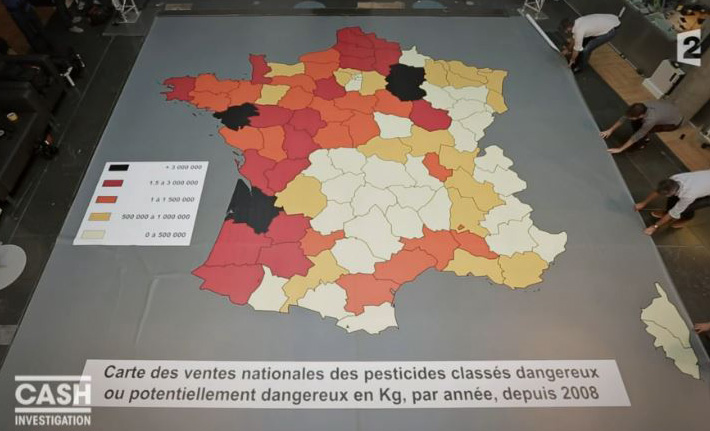Big data reveals the effects of pesticides
Commentary to “Cash Investigation. Produits chimiques, nos enfants en danger”, an investigation by Martin Boudot, aired on Feb 2, 2016 on France 2.
The “French 2” investigative tv program “Cash Investigation” looked this week into the use of pesticides in France and their effects on health on children. As usual for this type of program the investigation was based on a variety of interviews and research articles, however this time around they had topped it up with a large database of the use of pesticides in France. The database is not open to everyone and it took the journalist several months and a lot of pressuring to gain access.

Fortunately, they succeed so one could get a glimpse of what big data can do. In the episode, they then mapped the use of pesticides on to a map of France and visited areas with high concentration. In one location they even had the hair of school kids analysed to detect exposure to pesticides. Several research groups around the world have claimed that the exposure to pesticides have serious consequence for children’s development, especially their brains, and the viewers were presented to some concrete cases around the world in which it is assumed that pesticides have caused a high rate of mental illness.
What struck me was the usefulness of big data to get the facts straight, and I was excited to think how it could go one step further if the data was merged with data about the health of people living in the immediate vicinity. In such case, it may be possible to discover a wide range of illnesses caused by the many different types of pesticides.

One of the problems with the traditional research into this area is that it is expensive and receives little funding, so in consequence, only a few pesticides are being investigated. Big data could make it possible to investigate on a much larger scale and detect important relations. I assume that such data will still be of a “probabilistic” nature it may nevertheless highlight specific areas of concern which then can be investigated more thoroughly by a traditional research approach. In this way, big data—and algorithms—can advance health research by identifying specific areas of concern so the sparse research resources can be used in the most promising areas of investigation.